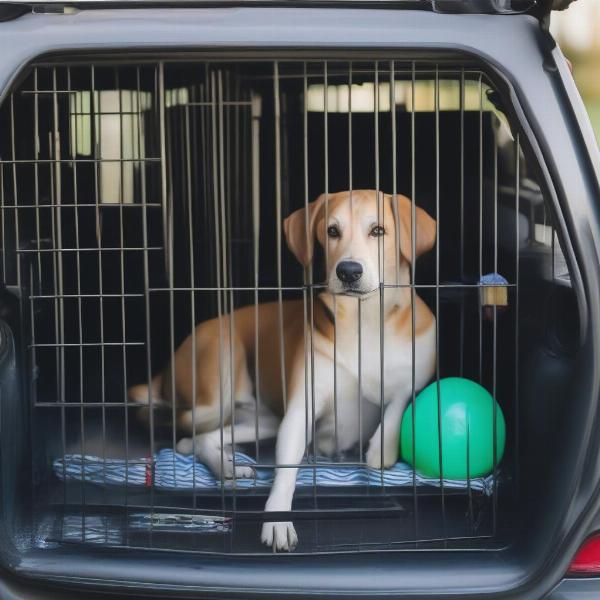Choosing the right dog cage for the back seat of your car is crucial for both your pet’s safety and your peace of mind. A properly secured dog can minimize distractions while driving and prevent injuries in case of an accident. This guide will cover everything you need to know about selecting, installing, and using a dog cage for the back seat, ensuring a comfortable and safe journey for your furry friend.
Choosing the Right Size and Type of Cage
The first step is determining the appropriate size. The cage should be large enough for your dog to comfortably stand, turn around, and lie down. Measure your dog’s height, length, and width while standing and add a few inches to each measurement to find the ideal cage dimensions.
There are several types of dog cages suitable for car travel, including:
- Metal wire crates: These are durable, well-ventilated, and relatively affordable.
- Plastic kennels: These offer more privacy and protection from the elements, making them a good choice for anxious dogs or during inclement weather.
- Soft-sided crates: These are lightweight and portable, but less durable than metal or plastic options. They are best suited for calm, well-trained dogs.
Which type is best for you depends on your dog’s temperament, size, and travel habits. For example, a nervous chewer might benefit from a sturdy metal crate, while a senior dog might prefer the comfort of a padded plastic kennel.
Securing the Cage in the Back Seat
Properly securing the cage is essential to prevent it from shifting or becoming a projectile during sudden stops or turns. You can use seatbelts, cargo straps, or dedicated cage anchors to secure the crate. Always follow the manufacturer’s instructions for installation.
Consider placing the cage on a travel dog mat to prevent it from sliding around and to protect your car’s upholstery.
Tips for a Comfortable and Safe Journey
- Introduce the cage gradually: Let your dog explore the cage at home before using it in the car. Associate it with positive experiences like treats and toys.
- Start with short trips: Gradually increase the duration of car rides to help your dog acclimate.
- Provide comfort items: Include a familiar blanket, toy, or chew toy to help your dog feel more secure.
- Never leave your dog unattended in a hot car: Even on mildly warm days, the temperature inside a car can quickly become dangerously hot.
- Offer water breaks: During long trips, stop regularly to offer your dog water and a chance to stretch their legs.
- Consider a car harness or seatbelt attachment: In addition to a cage, a harness or seatbelt attachment can provide an extra layer of safety.
Making the Most of Vehicle Dog Cages
Choosing the appropriate vehicle dog cages can significantly enhance both your dog’s safety and your driving experience. By following these guidelines, you can ensure comfortable and secure journeys for your furry companion.
 A dog comfortably resting in a car cage during a road trip
A dog comfortably resting in a car cage during a road trip
Conclusion
Investing in a suitable dog cage for the back seat of your car is an investment in your dog’s safety and well-being. By carefully considering the size, type, and security features, you can ensure a comfortable and stress-free travel experience for both you and your furry friend. Remember to prioritize your dog’s comfort and safety throughout the journey, and always follow best practices for car travel with pets.
FAQs
-
What is the best type of dog cage for a car? The best type depends on your dog’s individual needs. Metal crates are durable, plastic kennels offer more privacy, and soft-sided crates are lightweight and portable.
-
How do I secure a dog cage in the back seat? Use seatbelts, cargo straps, or dedicated cage anchors to secure the crate. Always follow the manufacturer’s instructions.
-
Can I leave my dog in a cage in the car while I run errands? Never leave your dog unattended in a car, especially during hot weather. Temperatures inside a car can quickly become dangerous.
-
What should I put in my dog’s cage for car travel? Include a comfortable blanket, a favorite toy, and a chew toy.
-
How can I make car rides less stressful for my dog? Introduce the cage gradually, start with short trips, and provide comfort items.
-
What if my car is too small for a standard crate? Consider a dog crate for small car specifically designed for compact vehicles.
-
How often should I stop for breaks during a long car trip with my dog? Stop every 2-3 hours to offer your dog water and a chance to stretch their legs.
About ILM Dog
ILM Dog is your trusted source for expert advice on all aspects of dog care and ownership. From breed selection and puppy care to senior dog health and training tips, we offer a wealth of information to help you provide the best possible care for your canine companion. We specialize in breed information, health and wellness, training and behavior, nutrition, grooming, and product recommendations. For any inquiries, please contact us at [email protected] or call us at +44 20-3965-8624.